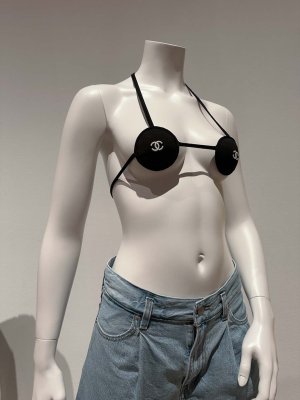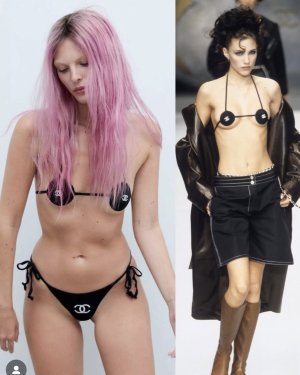PUCK NEWS
We Don’t Talk About Bruno
News and notes on the subtle transformation at Chanel under Leena Nair and, now, Matthieu Blazy, as the Pavlovsky era appears to be fading.
Pavlovsky, right, represents the last vestige of the old way of doing things, and it seems that Nair, left, is priming one of his deputies to effectively succeed him when he retires. Photo: Ludovic Marin/AFP/Getty Images
Last week, after Chanel released its 2024 report, the phrase “sales slide” appeared in numerous headlines—a reference not only to a 4 percent decline in global sales at the megabrand, but also a 28 percent drop in profits. But these results didn’t shake me. After all, Chanel is a private company that only publishes its numbers to appease the nosy press. Chanel also reported $3.4 billion in post-tax earnings, and spent $1.8 billion on capital expenditures (a 43 percent increase from the previous year), plus $2.5 billion on “brand activities,” from marketing to off-piste runway shows catering to loyal clients. The company added nearly 1,900 employees, too. It was an investment year at Chanel.
That’s not to say the numbers don’t betray a great deal about the current state of the company, and broader concerns about the future of the luxury industry, which is experiencing the greatest slowdown in its history—even worse than during the Great Recession. This is a time of monumental transition, there’s no way around it.
Matthieu Blazy’s appointment as the brand’s “artistic director of fashion activities” doesn’t simply connote a generational changeover, but rather a
complete strategy overhaul led by C.E.O.
Leena Nair.
Nair’s 30-year tenure at Unilever, primarily in human resources, has made her an efficiency queen—an executive focused on streamlining operations while somehow enabling employee satisfaction. It’s remarkable how much she has already accomplished in less than four years at Chanel, given the old-fashioned and entrenched way in which it was previously run. Credit to the
Wertheimer family, its owners, for recognizing that Chanel is a massive global entity that needs to be managed as incisively as the label on a stick of deodorant. Gone are the days of sentimental decision-making and the
pas possible attitude that pervades French culture. The layoffs that took place in the U.S. earlier this year—about 80 people in the first tranche—showed that this is no longer
Bruno Pavlovsky’s Chanel, despite the fact that the company’s once ubiquitous president of fashion has continued to serve as a spokesperson during each runway season.
Pavlovsky represents the last vestige of the old way of doing things, and it seems that Nair is priming one of his deputies—presumably the American
Joyce Green, who moved to Paris in early 2024—to effectively succeed him when he retires. Chanel insiders suggested that Pavlovsky’s receipt of the French Order of Merit by
Emmanuel Macron a few weeks back was an indication that his planned
denouement is likely sooner than perhaps anticipated. While Pavlovsky was integral in the hiring of Blazy—who attended his ceremony at Élysée Palace earlier this month—it may not make sense in the reorganization to have a president of fashion, per se.
Pavlov vs. Pavlovsky
Nair, as I’ve previously reported, is rearranging the business in such a way that will require a tremendous amount of agility and flexibility from its executives—un-siloing the operations, for instance, so that beauty and fragrance, fine jewelry, and fashion operate collaboratively, while also ensuring that no one in the organization ever has as much power as
Karl Lagerfeld once did. Green represents a bridge between the old world and the new, and is comfortable working across categories. Pavlovsky may be only 62—the same age as
Tom Cruise!—but he has worked at the firm since
1990, and may be less open to change.
Nair can achieve all this only because of the strength of Chanel, which sits at a truly unique spot on the luxury brand heat map. It is the most recognizable fashion house in the world, with the clearest identifiers—quilted leather, grey jersey, pearls, bouclé, gold link chains, ballet flats, flap bags, boxy jackets, etcetera—and an owned-and-operated fragrance and beauty business that drives volume. A friend recently asked me how many people buy full-price Chanel products every year: I’d estimate that they sell between 700,000 to 1 million handbags globally. So just think about how many lipsticks that must mean.
It is, indeed, a
mass brand, and executives have been able to continue to impart its specialness while selling more (or as much) product. In 2017, Chanel generated $10 billion in sales; seven years later, that number was $18 billion. Does it have to be so big? It’s a question for the Wertheimer family
and the fashion industry at large, which is nearing the end of its consolidation cycle, and seemingly forfeiting its position at the center of culture. There are few lines out the door, and demand is softening in China and the United States. Chanel’s decline in these regions, despite its best efforts, indicates the need for a different strategy.
Brands that have performed over the past year—Hermès, Loro Piana, Bottega Veneta, and Louis Vuitton—were all built on practical goods, not couture. Chanel cannot escape its history as a couture house, but that means it cannot simply mimic the Hermès approach. Like many luxury companies, Chanel has focused its effort on ultra-high-net-worth customers—those who spend $1 million a year or more at Chanel alone—and then the entry beauty customer, perhaps inadvertently neglecting the vast and still-privileged middle. Reading between the lines of the results, it’s clear that leather goods—not mentioned once in the release—likely pose the biggest challenge. As Pavlovsky has admitted himself, the perceived value of the bags does not match the actual prices. (This isn’t a leather goods house, and a 2.55 will almost certainly never garner the same level of respect as a Birkin.)
But I’d also point out the tremendous effort to increase direct-to-consumer beauty sales by opening standalone stores in China, especially. This strategy suggests that beauty and fragrance sales have slowed as the market has saturated, and the company is looking for new distribution opportunities on top of ways to widen margins.
Delphine’s Dior
Historically, Chanel has been a first mover in the market on so many fronts—from the appointment of Lagerfeld in the early 1980s and the seasonalization of leather goods in the 1990s, to the current direct-to-consumer beauty push. The arrival of Blazy, who will show his first collection in October, is the latest example. Back in the early days of Lagerfeld, and well into the ascendance of LVMH with
Marc Jacobs at Louis Vuitton and
John Galliano at Dior, the job of the designer was to create a halo effect that the company could use to push other products. At some point, that changed, and the
designer became responsible for pushing the commercialized
product, too. Now, in a transformed market, Blazy is something of a hybrid: His runway designs are meant to stoke sales, but Chanel’s new model, in which the wheels can successfully turn without a creative visionary steering, does not put all the onus on him.
It’s a bit different than what’s going on at Dior, which seems to be reverting to the old model in an attempt to revive sales. There’s no doubt that new Dior designer
Jonathan Anderson has the hardest job in fashion as he attempts to create something novel and agenda-setting for his first men’s show. He must please Dior C.E.O.
Delphine Arnault, collaborate with marketing head
Olivier Bialobos, and wait patiently for the
Maria Grazia Chiuri situation to resolve itself, with the knowledge that Dior is
Bernard Arnault’s most prized possession. (There are no politics as tricky as those at Dior. It was, after all, Arnault’s first acquisition.)
And yet, Chanel is the brand on which B.A. built Dior, and on which the rest of the industry modeled itself for decades. Pavlovsky has said that the company will exhibit patience with Blazy, and allow him to develop his practice while the Chanel engine keeps chugging.
That may be true, but it kinda has to work.




